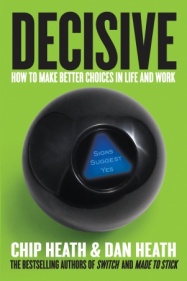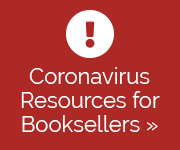Wi9 Plenary Speaker Dan Heath on Getting a Sense of Perspective on Your Toughest Decisions
- By Dan Cullen
 The opening plenary speaker for Winter Institute 2014 will be bestselling author Dan Heath, who will talk about why so many critical business decisions are flawed, and — more importantly — how booksellers can do better.
The opening plenary speaker for Winter Institute 2014 will be bestselling author Dan Heath, who will talk about why so many critical business decisions are flawed, and — more importantly — how booksellers can do better.
Here’s the third in a series of key insights and tips from Decisive, in anticipation of a plenary talk that will do much to answer the question of how we can make better choices in life and work.
Dan Heath and his brother, Chip, are the co-authors of the bestselling business book Decisive (Crown Business), which explores key aspects of the decision-making process and offers insightful strategies and practical tools to help individuals and businesses make better decisions.
 A key concept regarding decision-making in Chip and Dan Heath’s Decisive is what they term the WRAP process. As they point out, to make better choices, we must avoid the most common decision-making biases. Simple awareness often is not sufficient to avoiding them, but a process can help. The WRAP process is a big asset in making better, bolder decisions.
A key concept regarding decision-making in Chip and Dan Heath’s Decisive is what they term the WRAP process. As they point out, to make better choices, we must avoid the most common decision-making biases. Simple awareness often is not sufficient to avoiding them, but a process can help. The WRAP process is a big asset in making better, bolder decisions.
The Wrap Framework
- Widen Your Options
- Reality-Test Your Assumptions
- Attain Some Distance Before Deciding
- Prepare to Be Wrong
Step 3: Attain Some Distance Before Deciding
Many of our day-to-day decisions are made easily — even unconsciously — but there are some decisions that we agonize about. We find ourselves awake in the middle of the night, rehashing the same arguments in our heads. To break the mental logjam on these decisions, we need to attain some distance. Here are some strategies to get a sense of perspective on your toughest decisions:
Shift perspectives to gain distance. Here’s the key question to ask when you’re stuck on any personal dilemma: What would I tell my best friend to do, if he or she was in the same situation? And here’s a similar question for work dilemmas, one that comes from the former CEO of Intel, Andy Grove: “If we got kicked out and the board brought in new people to replace us, what do you think our successors would do?” Sometimes, these quick shifts in perspective can help us detach from short-term emotion and see the bigger picture more clearly.
If you’re stuck, you need new stimuli. An agonizing decision is often a sign that you need more choices or more information. Try running back through earlier stages in the WRAP framework. Can you Widen Their Options? Can you Reality-Test Their Assumptions?
Fight the “status quo bias.” Psychologists have studied two powerful forces that affect our decisions: First, we tend to like familiar things more than unfamiliar things. Second, we find losses more painful than commensurate gains are pleasurable. When you put these two forces together, you get a strong preference for the status quo. And that “status quo bias” can create deeply entrenched inertia in organizations. To resist this bias, try imagining that you could “reset” the status quo. If you or a colleague has a problematic relationship with a vendor, ask the question: If you weren’t already working with that firm, would you start the relationship from scratch? (If not, what’s so bad about ending it?)
Identify and enshrine your core priorities. Start one of your daily or weekly meetings by spending five minutes on your core priorities — reminding your bookselling colleagues of what you’re trying to achieve. (“We’re here to provide a welcoming third place — community, in-person customer service, discovery, and a curated book selection.”) State your core priority explicitly and return to it frequently, as you deliberate, so that it can tip your decision in the right direction. If you’re stuck between two options, it makes sense to let your core priority be your tie-breaker. Often leaders assume that these core priorities are obvious, but that’s a dangerous assumption to make. What’s obvious to you may not be obvious to your front-line workers.

